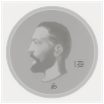Dorla
The dorla is the standard currency of Sudland. Dorla are silver coins, stamped with the likeness of King Haakan Larssen, the mint mark, "D" for Daskar or "S" for Southport, and the indication of value "1D" on the obverse, and the flag of Sudland and the year it was minted on the reverse. A dorla weighs exactly the same as one Kindorla. The dorla is a round disk with a diameter equal to the width of tu (2) Kinhundul (0.72 in, 1.83 cm) and a thickness of yat syodul (1/4) of yat kinhundul (0.09 in, 0.23 cm).
In addition to the dorla, coins with the value yat syodul (1/4) of a dorla, yat tundul (1/10) of a dorla, and yat hundul (1/100) of a dorla are produced at the Royal Mints. Those coins are known colloquially as "syodul," "tundul," and "hundul, respectively.
Manufacturing process
Round coin blanks for dorla and other coins are stamped from sheets of silver produced at the mints. The scrap silver produced from stamping coin blanks is collected, remelted, and forged into new sheets of silver for making coins.
Dorla are minted by stamping in the coin presses at the Royal Mints. The presses at Daskar and Southport can mint about 2500 dorla per day; however, fewer dorla than that are actually produced, as the mints also produce quarter dorla (syodul), tenth dorla (tundul), and hundredth dorla (hundul) coins.
History
The dorla was created and its value defined in the year CR 5747 as a result of the decree by King Haakan Larssen establishing standards for weights, measures, and currency, Royal Establishment of Weights, Measures, and Currencies for the Kingdom of Sudland, for the new kingdom of Sudland. The weight and dimensions of the dorla were based on the Kindorla coinstructed by the grandmother of Laesa Silverbraid at the Royal Forge and Smith in Daskar.
Significance
The dorla was and is hugely important in the commerce of Sudland. By standardizing weights, measures, and currency, King Haakan Larssen facilitated trade and commerce throughout the country, and also with foreign countries, as accurate weights and measures and trusted currency made contracts much easier to produce and enforce and transactions much less likely to result in fraud and disputes.
Item type
Currency & Deeds
Creation Date
CR 5747 Sam Masajoy, (3rd day of the 9th month of the year 5747 in the Common Reckoning)
Rarity
The dorla is the standard currency of Sudland, so there are at least tens of thousands in circulation.
Weight
Each dorla weighs exactly the same as 1/10 of a Kinhundul (1/100 lb.)
Dimensions
The dorla is a round disk with a diameter equal to the width of tu (2) Kinhundul (0.72 in, 1.83 cm) and a thickness of yat syodul (1/4) of yat Kinhundul (0.09 in, 0.23 cm).
Raw materials & Components
The dorla is minted from silver ore smelted at the Royal Mints in Daskar and Southport. The ore comes from rich veins of silver found only in the Royal Silver Mines in the Central Range, and only silver ore from those mines is used in minting dorla. The use of this special ore has two results. First, dorla are much more durable than silver coins minted from silver smelted from other ores. Second, detecting counterfeits is easier, as the weight of every dorla is standardized, based on the weight of the Kindorla, which is made from the same silver as common dorla.
Tools
The Royal Mints at Daskar and Southport each have ten coin presses dedicated to producing dorla, along with the required dies. The dies for the obverse of the Dorla are engraved with the likeness of King Haakan Larssen, the mark of the mint, "D" or "S" and the mark of value "1D". The dies for the reverse side of the dorla are engraved with the flag of Sudland and have slots for inserting the die indicating the year that the dorla was minted. Every year new dies for the year are produced. Each die can produce four dorla with each stamping.



Comments